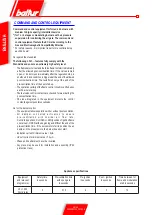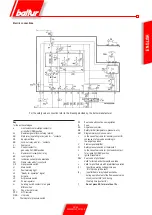
N° 8608/1
23 / 44
0006080103_201309
AIR REGULATION ON THE COMBUSTION HEAD
The combustion head is provided with a regulation device that closes (forward movement) or opens (backward movement) the air passage
between disk and head. By closing the passage, it is thus possible to obtain a high pressure upstream of the disk also for low flow rates.
High velocity and turbulence ensure a better penetration in the fuel, an optimum mixture and good flame stability. It may be necessary
to have high air pressure upstream of the disk to prevent flame pulsations. This condition is indispensable when the burner works with
a pressurized furnace and/or has a high heat load. From what said above it is evident that the device closing the air on the combustion
head must be set to such position as to always obtain, behind the disk, a very high air pressure value. It is recommended to provide an
air closure on the head, such to require a considerable opening of the air damper that regulates the burner fan intake flow. Obviously this
condition must occur when the burner operates at the maximum required output. In practice, start by adjusting the device that closes the
air on the combustion head to an intermediate position, turning on the burner for a preliminary adjustment as described above.
When the maximum desired output is reached, correct the position of the device which closes air on the combustion head by moving it
forward or backward so that the air flow is appropriate for the output, with the air regulation damper noticeably open.
When reducing the air passage on the combustion head, make sure not to completely close it. Perfectly centre the combustion head with
respect to the disk. A combustion head not perfectly centred to the disk could lead to a wrong combustion and overheat the same head
causing its early wearing.
Check it by looking through the inspection hole
on the burner rear side, and then fully tighten the
screws that lock the air regulation device on the
combustion head.
Check that ignition is correct because if the
regulator is shifted forward, the outgoing air
speed may be too high to permit ignition.
If this happens, gradually move the
regulator back to a position in which
ignition takes place correctly, and
accept this as the final position.
It should also be remembered that, for the
1st flame, it is preferable to limit the quantity
of air to that which is strictly indispensable
in order to have safe ignition even in the
most difficult circumstances.
AIR REGULATION SCHEMATIC DIAGRAM
WRONG ADJUSTMENT
Combustion head
Air passageway
wide open
Combustion head fastening and
control knobs
Combustion air inlet with gate
almost completely closed
Combustion head fastening and
control knobs
CORRECT ADJUSTMENT
Combustion air inlet
with gate valve noticeably open
Combustion head
Air passageway fairly
closed.
Attention: Do not close
completely
ENGLISH
Summary of Contents for GI MIST 350 DSPGM
Page 2: ......
Page 40: ...38 44 0006080103_201309 WIRING DIAGRAM ENGLISH...
Page 41: ...39 44 0006080103_201309 ENGLISH...
Page 42: ...40 44 0006080103_201309 ENGLISH...
Page 43: ...41 44 0006080103_201309 ENGLISH...
Page 44: ...42 44 0006080103_201309 RAMPA PRINCIPALE ENGLISH...
Page 46: ...44 44 0006080103_201309 ENGLISH...
Page 84: ...38 44 0006080103_201309 ESPA OL ESQUEMA EL CTRICO...
Page 85: ...39 44 0006080103_201309 ESPA OL...
Page 86: ...40 44 0006080103_201309 ESPA OL...
Page 87: ...41 44 0006080103_201309 ESPA OL...
Page 88: ...42 44 0006080103_201309 ESPA OL RAMPA PRINCIPALE...
Page 90: ...44 44 0006080103_201309 ESPA OL...
Page 128: ...38 44 0006080103_201309 FRAN AIS SCH MA LECTRIQUE...
Page 129: ...39 44 0006080103_201309 FRAN AIS...
Page 130: ...40 44 0006080103_201309 FRAN AIS...
Page 131: ...41 44 0006080103_201309 FRAN AIS...
Page 132: ...42 44 0006080103_201309 FRAN AIS RAMPA PRINCIPALE...
Page 134: ...44 44 0006080103_201309 FRAN AIS...
Page 135: ......














































